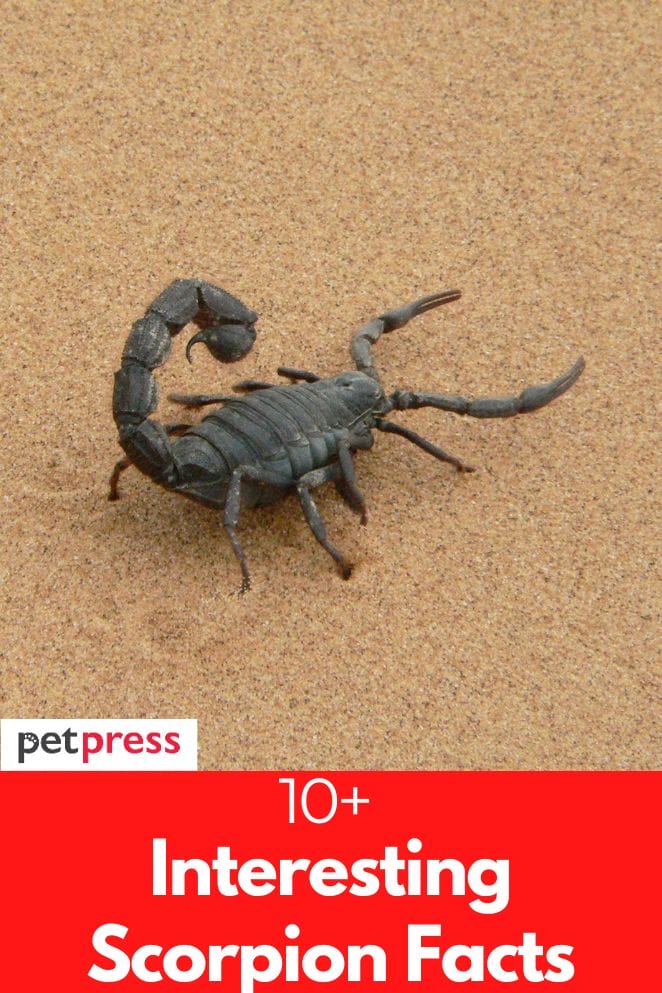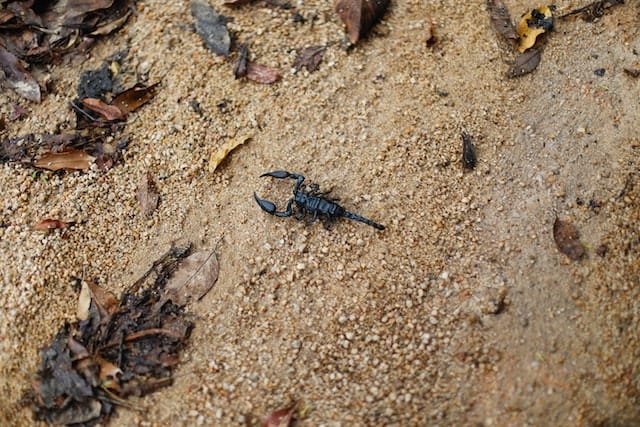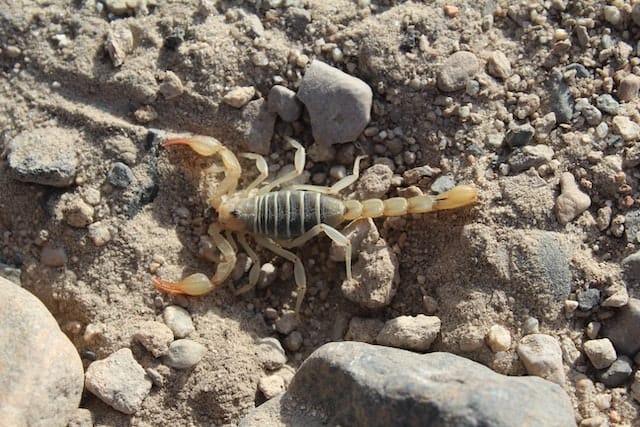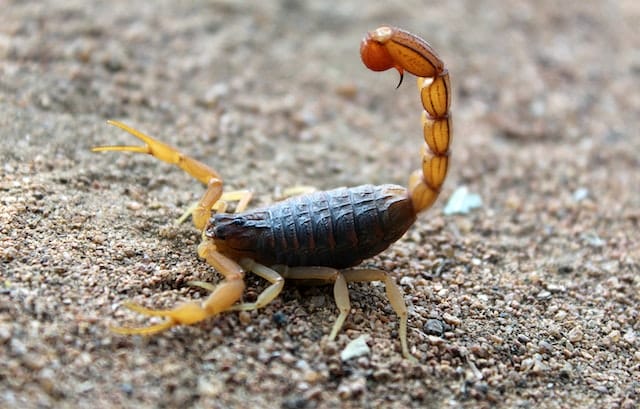
Scorpions are fascinating creatures that have been around for hundreds of millions of years.
They have a fearsome reputation, with their sharp claws and venomous stingers, but they also have some interesting characteristics that make them unique in the animal world.
In this article, we’ll look at some interesting facts about scorpions to help you appreciate these fascinating arachnids even more.
From their diet to their reproductive habits, here are some of the most interesting facts about scorpions. Enjoy!
Fact #1: Scorpions have eight legs and two large pincers.
Scorpions have an unmistakable appearance, with eight legs and two large pincers.
These pincers are used for catching prey, defending against predators, and sometimes even mating.
The legs are covered in sensory hairs, which allow them to detect vibrations in the air, alerting them to the presence of potential food or danger.
Scorpions typically walk on all eight of their legs, although they can move quickly by running on just six. Some species can even scuttle sideways like a crab!
Fact #2: Scorpions glow under Ultraviolet (UV) light.
Most people don’t realize that scorpions actually have the ability to glow under ultraviolet (UV) light.
This unique feature is due to special pigments in their exoskeleton, which become visible when exposed to UV light.
The color of the glow varies from species to species, ranging from an eerie greenish-blue to a bright neon yellow.
This ability can be used by researchers to identify different species of scorpions in the dark. It is also believed that the glow may help scorpions locate one another during mating season.
Fact #3: Scorpions are carnivores and feed on insects and other arthropods.

Scorpions are carnivorous predators that primarily feed on small insects and other arthropods. They also occasionally consume larger prey such as lizards, spiders, and mice.
Their diet usually consists of various invertebrates, including beetles, cockroaches, and crickets.
Scorpions possess powerful claws to capture their prey and a venomous stinger to paralyze it. They use the stinger to defend against predators and to subdue their prey.
Fact #4: Scorpions have an extraordinarily long lifespan.
Scorpions have an incredibly long lifespan when compared to other arthropods.
While the average lifespan of most species is only a few years, some scorpion species can live up to 25 years in captivity!
They are also capable of surviving months without food or water and can even withstand extreme temperatures.
This remarkable durability makes them well-suited to their arid environments and helps them survive long droughts.
Fact #5: Scorpions reproduce sexually.
Scorpions reproduce sexually, with a male and female coming together for courtship before mating.
During this ritual, the male scorpion will transfer a spermatophore to the female for fertilization.
The spermatophore is an external package of sperm that is attached to the female’s genital opening.
After mating, the female will lay a clutch of fertilized eggs and carefully guard them until they hatch.
The young scorpions tend to stay with their mother for some time after hatching before venturing out on their own.
Fact #6: Scorpions are found in every continent except Antarctica.
Scorpions can be found on all seven continents, with the exception of Antarctica.
They inhabit a wide range of habitats, from deserts and grasslands to tropical rainforests and caves.
Depending on the species, they may burrow in underground tunnels or hide among rocks, logs, and leaf litter.
Scorpions are well adapted to warm climates and can often be found in areas with temperatures above 100 degrees Fahrenheit (37.8 Celsius).
Such areas provide the scorpion protection from predators and a plentiful food supply.
- Related post: Top 150 Names Scorpions Names
- Related post: 10+ Interesting Spider Facts
Fact #7: Scorpions display a wide range of behaviors.

Scorpions are highly adaptable creatures and display a wide range of behaviors in the wild.
When threatened, they may use their powerful claws and venomous stingers in aggressive defensive displays.
On the other hand, they may cooperate with one another to hunt and feed, sharing food resources amongst the group.
Furthermore, some species of scorpions are known to practice “self-grooming,” using their claws and mouthparts to comb their bodies in a grooming behavior similar to primates.
Fact #8: Scorpions are a source of inspiration in many cultures.
Scorpions have long been sources of both fear and fascination for humans. They appear prominently in the artwork, literature, and mythology of many different cultures.
In some cultures, they are symbols of protection and strength, while in others, they represent evil and death.
Scorpions have been used to symbolize fearlessness, power, and resilience—qualities that are highly valued by many cultures around the world.
They have also inspired unique works of art, such as sculptures, paintings, tattoos, and jewelry.
No matter what your cultural background is, it’s hard to deny the allure of these mysterious creatures.
Fact #9: Scorpions are important members of their ecosystems.
Scorpions play an important role in the balance of their respective ecosystems.
They feed on various insects and arachnids, helping to keep pest populations in check.
This, in turn, helps to maintain a healthy balance of biodiversity and prevents any one species from becoming overabundant.
Scorpions also provide food for other animals, such as birds and mammals that prey on them.
In this way, they are an important part of the food chain.
Finally, scorpions break down organic matter, such as dead plants and animals, which helps to add nutrients to the soil.
All of these functions make scorpions an integral part of their ecosystems.
Fact #10: Scorpions are declining in many parts of the world.
Scorpions face several environmental threats that have caused populations to decline in many parts of the world.
Habitat destruction is one of the primary threats to scorpions, as humans continue to clear land for agriculture, urban development, and other uses.
Climate change is also having a major impact on scorpion populations by altering their habitats and reducing available resources.
Finally, over-collection for use in traditional medicines or the pet trade has led to declines in some areas.
All of these human activities are having a detrimental effect on scorpion populations, and it is important that we work to conserve these valuable members of our ecosystems.
Fact #11: There are many species of scorpions.

There are currently over 2,000 recognized species of scorpions worldwide, and many more have not yet been discovered or studied.
These species range in size from less than an inch to over six inches in length, and they come in various colors and patterns.
They can be found on every continent except Antarctica, living in a wide range of habitats from deserts to rainforests.
Because scorpions are so diverse, their behavior and biology vary greatly between species.
This makes them fascinating for scientists to study, and there is still much that we don’t know about these creatures.
As new species are discovered, and more research is conducted, our understanding of scorpions will continue to grow.
Fact #12: Scorpions have unique abilities.
Scorpions are incredibly resilient creatures that have evolved a range of unique adaptations to survive in a variety of environments.
One of the fascinating abilities they possess is the capability to produce their own food through photosynthesis.
This allows them to survive in areas where there are limited food sources or during times of drought.
In addition, scorpions have special sensors on their legs called pectins that help them to detect objects in the dark and navigate their environment.
They also produce venom to defend themselves from predators, although not all species are venomous.
Finally, some scorpions can even survive for long periods of time without food and water due to their ability to slow down their metabolism.
These facts demonstrate the importance of scorpions in many cultures and their significant role in the balance of ecosystems around the world.
Protecting scorpion populations is essential to ensure the health and stability of these important species.
We must work to conserve their habitats, reduce threats to their populations, and promote sustainable practices that benefit both scorpions and humans.
Doing so will help us ensure a bright future for these incredible creatures.


GIPHY App Key not set. Please check settings